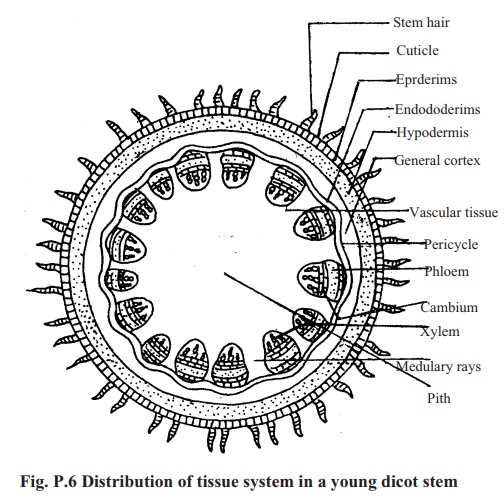Chapter: Biology: Practical Botany
Study of Distribution of Tissue System in Dicot Stem

STUDY OF DISTRIBUTION OF TISSUE
SYSTEM IN DICOT STEM
A young slender stem of a dicot plant is to be collected from
surroundings. Any plant such as Ban Sharisha (Rorippa indiea Muktajhuri (Acalypha
indica) may be chosen. Ricinus (Verenda) stem is wider in breath. It may
not be possible for the student to cut a transvers section of it. In such case
this type of broader stem may be splitted.
longitudinally before cutting transverse section at this
stage. It is sufficient to show the cuticle on the epidermis, circular
arrangement of vascular bundles. and in each vascular bundle xylem and phloem
tissues are present.]
Materials required:
A piece of stem of any dicot plant,
microscope, watchglass. water, sharp blade, safranin solution (red dye), brush,
slide and cover slip etc.
Procedure: Holding the young stem with the left hand, very thin
section(transverse section) is to be taken by a sharp blade holding in the
right hand. Water should be placed at the edge of the blade and on the cutting
end of the stem so that air does not enter into the section. Sections are to be
kept in water taken in a watch glass. A drop of water is to be placed on the
slide and then a uniformly thin section should be taken by a brush and placed
in the water drop on the slide. A little amount of safranin solution is to be
added in the water drop on the slide. Then a cover slip is to be placed over
the section and the section would be observed under a compound microscope.

Observation: In cross section the stem will appear more or less
circular inshape. In observation the following tissue system will be seen: A
single layered parenchymatous cells present at the outermost position of the
section; this is epidermal tissue, it
is called epidermis. Outside the epidermis there is a layerof cuticle.
In some plant unicellular or multicellular hairs may develop here and there
from epidermal cells. Inside the circular layer towards the middle of the
section there is another circular layer. Vascular bundles are encircled by this
layer and are arranged in a ring. Each vascular bundle consisting of phloem
tissue towards the periphery, a thin cambium layer (not easily visible) in the
middle and xylem tissue towards the center. The vascular bundles together form
the vascular tissue system. The zone
in between epidermis and vascular region is called the cortex. It is the ground
tissue system. The region surrounded by the vascular tissue is known as pith,
which is also ground tissue.
Conclusion: Cuticle present on the epidermis, xylem and phloem tissues
arepresent in each vascular bundle. So the section is of a young stem. Vascular
bundles are arranged in a ring, cambium present in between xylem and phloem, so
the section is of a stem of Dicot plant.
Related Topics